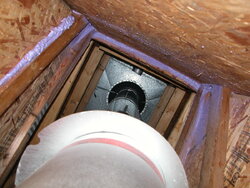I am having condensation problems and have a lot of conflicting info on how to fix the problem. if I can get a few more oppinions maybe i can arrive as some sort of consensus.
My house (Bungalow) has spray foam insulation (WallTite Eco) in the walls and right across the roof deck so the attic is a conditioned space. The chimney chase is a framed box starting at the ceiling and extending through the roof for about 3 feet. The portion of the chase that is within the attic is spray foamed on the attic side. There is no insulation on the portion above the roof line and the chase cover is simply metal with no insulation. The chase ia sealed at the ceiling and outside air enters the bottom of the chase and vents out the top (4" round vents top and bottom). Some advice says that this should be good; other advice says to insulate the top portion of the chase and the underside of the cover and remove the vents.
My concerns are:
A sealed chase, like a sealed attic, is seldom completely airtight. Without venting and warm air leakage into the chase is bound to create condensation.
If the chase is sealed up will the heat buildup from the double walled chimney reach dangerous levels. We will sometimes have a fire burning for 6 -8 hours or more. You cannot touch the double walled chimney at a point just above the ceiling. I have been unable to determine what the typical surface temperature would be near the top.
We do live in a cold climate (North Saskatchewan) with long spells of sub-zeroe temperatures. any comments will be appreciated. A pic is attached.
My house (Bungalow) has spray foam insulation (WallTite Eco) in the walls and right across the roof deck so the attic is a conditioned space. The chimney chase is a framed box starting at the ceiling and extending through the roof for about 3 feet. The portion of the chase that is within the attic is spray foamed on the attic side. There is no insulation on the portion above the roof line and the chase cover is simply metal with no insulation. The chase ia sealed at the ceiling and outside air enters the bottom of the chase and vents out the top (4" round vents top and bottom). Some advice says that this should be good; other advice says to insulate the top portion of the chase and the underside of the cover and remove the vents.
My concerns are:
A sealed chase, like a sealed attic, is seldom completely airtight. Without venting and warm air leakage into the chase is bound to create condensation.
If the chase is sealed up will the heat buildup from the double walled chimney reach dangerous levels. We will sometimes have a fire burning for 6 -8 hours or more. You cannot touch the double walled chimney at a point just above the ceiling. I have been unable to determine what the typical surface temperature would be near the top.
We do live in a cold climate (North Saskatchewan) with long spells of sub-zeroe temperatures. any comments will be appreciated. A pic is attached.


